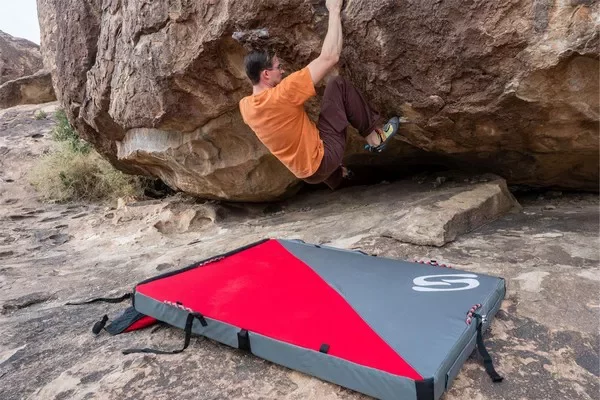Climbing, in its essence, is a pursuit of conquering vertical challenges, a dance between human athleticism and the raw forces of nature. Whether scaling the sheer face of a rock cliff or navigating an intricate indoor bouldering route, climbers face inherent risks. As such, safety equipment plays a pivotal role in mitigating these risks and ensuring climbers can push their limits without compromising their well-being. Among the arsenal of climbing gear, one essential tool stands out for its role in protecting against falls: the crash pad.
What Exactly is a Crash Pad?
A crash pad, also known as a bouldering pad or simply a pad, is a specialized cushion designed to provide impact protection for climbers during falls, primarily in bouldering or free climbing situations. These pads typically consist of multiple layers of foam encased in durable fabric, engineered to absorb and dissipate the force generated by a falling climber, reducing the risk of injury.
The Anatomy of a Crash Pad
Understanding the construction of a crash pad is crucial for assessing its effectiveness in providing protection. While designs may vary among manufacturers, most crash pads share common components:
1. Foam Core: At the heart of every crash pad lies the foam core, the primary mechanism for absorbing impact energy. High-quality crash pads utilize various densities and types of foam, strategically layered to optimize shock absorption while maintaining a lightweight and portable form factor.
2. Shell Material: Surrounding the foam core is a rugged shell made from durable fabrics such as nylon or polyester. This outer layer not only protects the foam from abrasion and punctures but also enhances the pad’s longevity under the rigors of outdoor use.
3. Closure System: Many crash pads feature a foldable or hinged design for easy transportation and storage. Secure closure systems, such as buckles or hook-and-loop fasteners, ensure the pad remains compact during transit and fully extends for optimal coverage during use.
4. Carrying Straps: Built-in straps or handles facilitate the transportation of crash pads to and from climbing areas. Adjustable shoulder straps or padded backpack-style harnesses enhance comfort during long approaches, while grab handles allow for quick repositioning when setting up for a climb.
The Role of Crash Pads in Climbing Safety
In the realm of bouldering, where climbers ascend shorter routes without the use of ropes, the risk of ground falls is inherent. Unlike traditional rock climbing, where ropes and harnesses provide protection against falls, boulderers rely on crash pads positioned strategically beneath the climbing route to cushion their descent in the event of a fall.
Crash pads serve several critical functions in enhancing climbing safety:
1. Impact Absorption: The primary purpose of a crash pad is to absorb the impact force generated by a falling climber, dispersing it across the pad’s surface and reducing the risk of injury upon impact with the ground.
2. Ground Stabilization: In outdoor climbing environments, the terrain beneath boulder problems may be uneven or rocky. Crash pads not only provide cushioning but also create a stable landing zone, minimizing the risk of ankle twists or other injuries caused by landing on unstable ground.
3. Fall Zone Extension: By strategically positioning multiple crash pads beneath a climbing route, climbers can effectively extend the “safe zone” for falling, allowing them to attempt more challenging moves with confidence knowing that a padded landing awaits below.
4. Environmental Protection: In addition to safeguarding climbers, crash pads also help protect the natural environment by minimizing soil erosion and vegetation damage caused by repeated landings in high-traffic climbing areas.
Choosing the Right Crash Pad
Selecting the appropriate crash pad for a climbing excursion involves considering various factors, including the type of climbing terrain, personal preferences, and budgetary constraints. Key considerations when evaluating crash pad options include:
1. Size and Thickness: Crash pads come in a range of sizes and thicknesses, with larger pads offering greater coverage and thicker foam providing enhanced impact absorption. Climbers should assess the specific landing zones at their intended climbing area to determine the optimal pad size and thickness for adequate protection.
2. Portability and Weight: For climbers who frequently embark on long approaches or multi-day trips, the portability and weight of a crash pad are crucial considerations. Lightweight yet durable materials and ergonomic carrying systems can significantly enhance the pad’s transportability without compromising on performance.
3. Durability and Quality: Investing in a high-quality crash pad is essential for long-term durability and reliable performance. Climbers should examine the construction quality, materials, and overall craftsmanship of a pad to ensure it can withstand the rigors of outdoor use and provide lasting protection.
4. Budget Considerations: While top-of-the-line crash pads may offer the most advanced features and superior protection, they often come with a higher price tag. Climbers should balance their budgetary constraints with their safety needs when selecting a crash pad, opting for the best combination of affordability and performance within their means.
Conclusion
In the dynamic world of climbing, where risk and reward intersect with every ascent, safety remains paramount. Crash pads represent a critical component of climbers’ safety arsenal, providing essential protection against ground falls and enhancing confidence when attempting challenging boulder problems. By understanding the purpose, construction, and selection criteria of crash pads, climbers can make informed decisions to ensure their safety and enjoyment in pursuit of vertical adventure.

